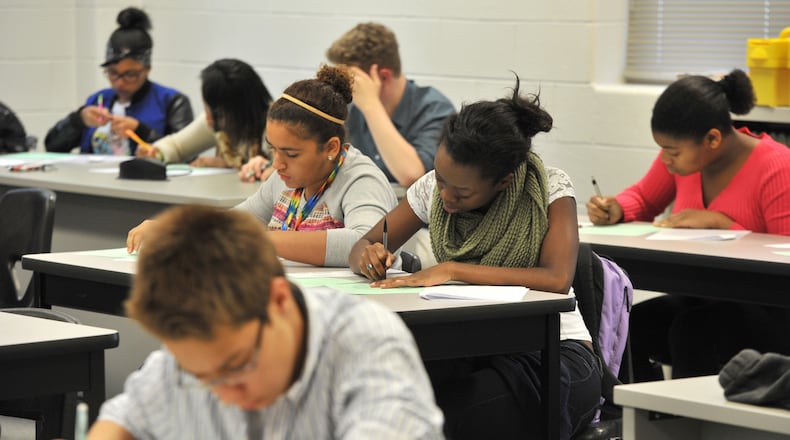Scores on Georgia’s redesigned education report card released Monday show high schools faring the worst under the new model.
State education officials say the revised College and Career Ready Performance Index is so different from prior years that the scores cannot be compared. However, the statewide average scores for elementary and middle schools rose while the score for high schools declined, suggesting that either high school students did worse when they took their state standardized tests last spring or that the new measure is tougher on high schools than on the lower grades.
Overall, the statewide score on the 100-point index rose just over a point. The average scores were: 77.8 for elementary schools, 76.2 for middle schools and 75.3 for high schools. The overall average: 76.6.
Though the scores are not backwards compatible, they can be used to compare schools and school districts.
Among the five major metro Atlanta school districts, Gwinnett County Public Schools had the best elementary school score at 84.6 points, followed by Fulton County, Atlanta Public Schools, Cobb County and DeKalb County, in that order. Gwinnett middle schools also led with 84.5 points, with the other districts in the same descending order except for Cobb and Atlanta, which swapped places. Cobb did best among high schools, with 85.4 points, trailed by Fulton, Gwinnett, DeKalb and Atlanta.
Both Atlanta and DeKalb failed to beat the state average for those three grade clusters. Cobb failed to beat it for elementary schools.
The scoring system is built on a variety of measures, leaving school districts the opportunity to tout the best-looking details. Cobb, for instance, pointed to its total average score for all schools of 79.6. "Schools in the Cobb County School District outpaced their peers across the state, yet again," the district proclaimed, though it had no elementary school among the top 10 for metro Atlanta.
And DeKalb, despite it's poor showing on average, had the best-scoring metro high school and middle school: DeKalb Early College Academy earned 96.6 points; Kittredge Magnet School's middle school cluster was a tenth of a point shy of a perfect 100. Among elementary schools, Gwinett's Riverside Elementary School led metro Atlanta with a 98.5. Indeed, the district had six elementary schools in the area's top 10, leaving two slots for Fulton and one each for Atlanta and DeKalb.
The revised report card was designed by state school Superintendent Richard Woods as part of Georgia’s compliance with overhauled federal education law. In 2015, Congress passed the Every Student Succeeds Act, ending more than a decade under the old No Child Left Behind Act, which many saw as over-reliant on standardized tests.
Georgia's new measure, part of the state plan approved by the U.S. Department of Education earlier this year, diminishes the impact of test results by giving schools credit for providing non-core academic opportunities in areas such as the arts, foreign language, physical education and advanced coursework. Though U.S. Education Secretary Betsy DeVos appreciated the design, Gov. Nathan Deal rejected it, saying it "falls short in setting high expectations" and tells school districts how to run their schools.
Despite the reduced reliance on test scores, this new version of the CCRPI is still mainly a measure of student performance on the Georgia Milestones, the tests given at the end of courses in high schools and at the end of the year in elementary and middle schools. Even Woods has criticized his own measure, saying it is still roughly 80 percent derived from high-stakes test results.
At prestigious schools and universities, Woods wrote, test scores are a “footnote.” But Georgia’s public schools have “the reverse approach.”
The reliance on tests is a mandate under both state and federal law. But the federal government is allowing states some leeway for alternatives. Woods is exploiting a new Georgia law that allows school districts to experiment with alternative tests. His education agency is seeking a federal waiver that would let 21 of the state's 180 school districts use their own exams to gauge student progress, with the ultimate goal of substituting them for the state standardized tests.
About the Author
Keep Reading
The Latest
Featured


